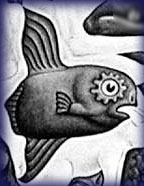

Molid Ancient History and Folklore
The earliest written records of mola that I’ve been able to find date back to Pliny the younger who, according to Wikipedia, had the real name of Gaius Plinius Caecilius Secundus, lived from 63 – ca. 113 and was a lawyer, author and a natural philosopher of Ancient Rome. Pliny quotes Apion as saying that the largest of fishes was the porcus (pigfish), called Orthagoriscus by the Lacedaemonians, and states that it grunted when taken. The Orthagoriscus of Pliny was referred by Rondelet to a fish then known as mole at Marseille which was apparently the headfish or sunfish, Orthagoriscus mola. Note: molas can gnash their long throat teeth together and make a grunting sound when removed from the water.
A bit closer to home, a 2001 study of archeologial remains in California suggests there was a rather robust prehistoric mola fishery on the southern California coast. For a truly inspired and hysterical YouTube video on this findings check out: http://www.youtube.com/watch?v=X4smMyPNcA0. This film is based on the following article: J. Porcasi and S. Andrews (2001) Evidence for a Prehistoric Mola mola fishery on the Southern California Coast, Journal of California and Great Basin Archaeology, Vol 23 No 1.
Not much is known about the cultural significance of mola. According to Margaret Titcomb, author of Native Use of Fish in Hawai’i, the Hawaiian names for mola include: Kaumakanui which literally translates to big eyes placed on it; Kunehi apahu (cut off) and Kunehi makua (king). It is this last name from which the following legend arose. Polynesians are said to have called the sunfish makua or “King of the Mackerels”. It was bad luck to catch and kill sunfish for such an act would render the mackerel incapable of finding their way to the islands and subsequently into the fishermen’s nets.
In Japanese culture, mola were once used as a form of tax payment by Shoguns several centuries ago. And today mola are an adored fish throughout the country of Japan. The seaside town of Kamogawa in the Chiba prefecture has even chosen the mola as their town mascot. And various places throughout Japan offer the opportunity to swim with mola as a tourist attraction.
If you know of any mola legends or lore, please do pass them along my way.
See also:
Alfred C. Andrews, 1948, Greek and Latin Mouse-Fishes and Pig-Fishes Transactions and Proceedings of the American Philological Association, Vol. 79. pp. 232-253. http://links.jstor.org/sici?sici=00659711%281948%2979%3C232%3AGALMAP%3E2.0.CO%3B2-K.
Was the Patron Saint of Cornwall rescued by a fish, an ocean sunfish maybe??
St Piran was brought up in South Wales in the 5th century and founded a church in Cardiff. He then moved to Ireland where he became famous for healing the sick. However, according to legend, in his old age he was captured by a band of pagans. These ruffians tied a millstone around his neck and flung him off a high cliff at the height of a raging storm. Miraculously as he sank beneath the mountainous waves the storm calmed, and the millstone floated up taking him with it. Piran clambered on to the millstone and using it as a raft sailed away on it. He landed at Perran Beach in North Cornwall, where he set up a church, discovered tin for the Cornish, and performed many further miracles.
Could St. Piran’s millstone have been a fish? The Sunfish with it large grey round shape has the scientific name of Mola mola, meaning, guess what, MILLSTONE. So maybe he was simply thrown into the water from the cliff top and when he bobbed up to the surface was able to seize hold of a passing sunfish, which recognised him as a holy man and towed him to safety in Cornwall. In summer you can often see sunfish swimming around headlands, especially in North Cornwall; perhaps they are coming by to check if St Piran needs their help again.
submitted by Douglas Herdson
